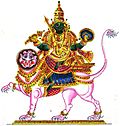Top Qs
Timeline
Chat
Perspective
Navadhanya
Nine essential grains in Indian cuisine From Wikipedia, the free encyclopedia
Remove ads
Navdhānya or Navadhaniyam refers to nine food grains namely wheat, paddy, pigeon pea, hyacinth bean, chickpea, mung bean, sesame, black gram and horse gram.[1][2] Navdhānya means "nine grains" in several Indian languages and form an essential part of Indian cuisine.[3]
Hindu theology
In Hindu cosmology, Navdhānya are considered to represent the Navagraha (nine planets).[4] The grains represent the following nodes:[5]
Remove ads
Worship and rituals
It is customary for Hindus to use Navdanya during certain rituals and auspicious events.[6][7] During traditional Hindu initiation ceremonies such as Upanayana that marks the acceptance of a student by a preceptor and Vidyāraṃbhaṃ that is performed before a child begins their formal education involve the offering of navdhanya.[8] During festivals such as Saraswati Puja, a new scroll and writing equipment are placed on the navdhanya.[9]
In Mariamman worship in South India, the sprouts of these food grains, traditionally known as mullaipaari forms an important part of festivals and rituals.[10] The seeds are grown on temporary trays or pots and are either allowed to sprout in the temple or carried to the temples after sprouting. If the seeds sprout healthily, it is considered as a good sign and an indication of an upcoming good harvest.[11]
Remove ads
References
Wikiwand - on
Seamless Wikipedia browsing. On steroids.
Remove ads








